There are numerous benefits to owning one of the best self-evaporating portable air conditioners besides hardly emptying the water tank. However, you’ll need to know what aspects to look out for and how to compare prices with value.
This article will guide you through the different selection processes and show you some of the top products available on the market.
At a Glance: Our Top Picks for Self-Evaporating Portable Air Conditioners
- OUR TOP PICK: Black+Decker BPACT08WT
- RUNNER-UP: Nepo NPP-A112C
- Black+Decker BPACT14WT
Comparison of the Best Self-Evaporating Portable Air Conditioners
| IMAGE | PRODUCT | |
|---|---|---|
Our Top Pick  |
| View Latest Price → |
 |
| View Latest Price → |
 |
| View Latest Price → |
 |
| View Latest Price → |
 |
| View Latest Price → |
Aspects to Consider Before Buying a Self-Evaporating Portable Air Conditioner
Self-evaporating portable air conditioners are excellent for maintaining room temperatures while reducing the need for drainage. There are several factors you should consider before blindly purchasing one.
Size
The air conditioner’s size directly relates to its performance and power. A factor often ignored by customers is the room’s size, as you’ll need to make sure that the device’s British Thermal Units (BTU) are capable of effectively cooling or heating the room.
For instance, an 8,000 BTU air conditioner will work in a space of up to 200 sq. ft. On the top end, you can grab a 14,000 BTU unit for up to 500 sq. ft.
Placement
When the self-evaporating portable air conditioner cools a room, it needs to exhaust the hot air out of the house. Some devices have a window, depending on the model.
You’ll need to evaluate which window you’ll use and see if the kit will work in your home. Additionally, make sure the air conditioner can cover the entire room from that position.
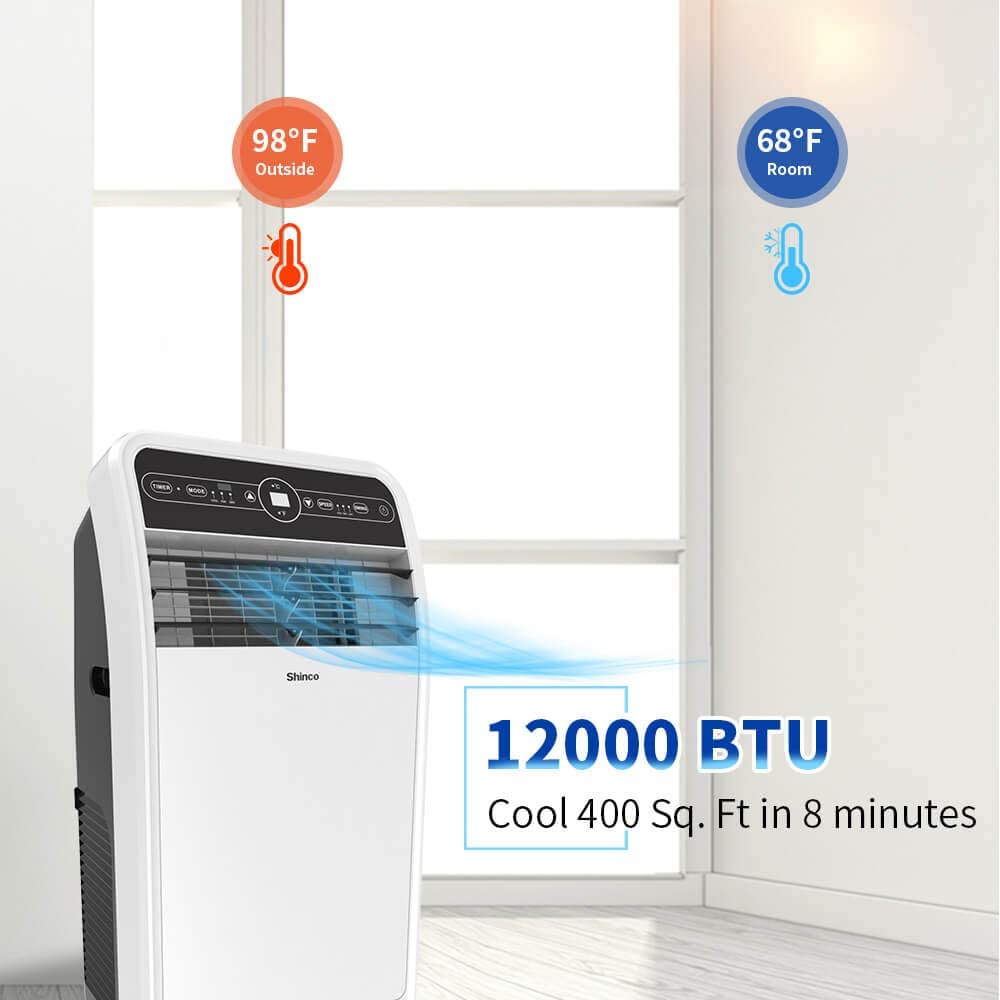
Maintenance
The components will wear down over time, and you’ll need to make sure to clean them regularly while removing any filters that may be present. The exhaust hose may also need some maintenance or replacement over time.
Check how much maintenance will be needed for the unit you’re looking at and how much it will cost you in the long run. You may also want to assess how much the replacement costs are per part.
Efficiency
Maintenance cost isn’t the only expense you’ll suffer. Air conditioners are notorious for being some of the largest culprits of high monthly utility costs.
Fortunately, some manufacturers consider energy-efficiency for this exact reason. Look at the Energy Efficiency Ratio (EER) to ensure low monthly running costs.
Noise
One of the worst things you can do is buy a noisy portable air conditioner for your bedroom. You’ll struggle to sleep, or it may even keep your children up at night, leading to an unpleasant morning the following day.
There are plenty of powerful products on the market that have silent performance. The noise levels are measured in decibels (dB), so compare this category among the air conditioners you are eyeing.
Review of the Best Self Evaporating Portable Air Conditioners
It’s time to look at our selection of the best self-evaporative portable air conditioners available. Please keep in mind that we have selected these products based on specific criteria, and you’ll need to evaluate whether they’ll fulfill your needs.
Best Overall
Black+Decker BPACT08WT

Product Ratings
Affordability:
Portability:
Noise:
Performance:
Ease of Setup:
Cost Efficiency:
How We Determined These Scores
We may earn commission from purchases made from our links, at no additional cost to you
Quick Product Specs:
BTU DOE: 5,000
Cooling Capacity: 350 sq.ft.
Size & Weight: 12x17x26″ ; 53 lbs
Avg. Yrly Cost: $93/yr
Decibel Levels: 49 dB
With cool, fan, and dehumidifying modes in one package, this portable AC is truly a jack of all trades. Thanks to the standard wheels, simple instructions, and the included hoses, just whisk this unit into place, attach the hoses, and you’re done.
The final accouterment to this dependable air conditioner is the ease of cleaning. Simply slide out the filter twice a month, rinse it with water, and replace. Not only is it simple, but it’s also environmentally friendly.
Bottom Line
If you’re searching for an air conditioning unit with maximum performance and portability, this is the best option for you. And with a one-year warranty and whisper quiet performance, you won’t have to worry about it driving you nuts or going kaput soon after your purchase.
Pros
Quietest operation in the segment
One-year limited warranty
Comes with a remote control
Cooling power down to 65 degrees
Superior efficiency
Cons
Comes with only a single hose
Rigid hose requires the unit to sit away from the window, which can add a cluttered feel
Runner-up
Nepo NPP-A112C

Product Ratings
Affordability:
Portability:
Noise:
Performance:
Ease of Setup:
Cost Efficiency:
How We Determined These Scores
We may earn commission from purchases made from our links, at no additional cost to you
Quick Product Specs:
BTU DOE: 6,500
Cooling Capacity: 350 sq.ft.
Size & Weight: 13×13.5×28″ ; 54 lbs
Avg. Yrly Cost: $122/yr
Decibel Levels: 52 dB
An excellent advantage of this unit is the remote control that provides added convenience no matter where you are in the room. Wheels give you the option of putting this by the window or closer to where you’re sitting, making it the better option compared to window units.
Bottom Line
Although the brand isn’t as well-known as some other options on the market, the sleek design and excellent portability make this unit a force in the world of self-evaporating air conditioners
Pros
Superb portability thanks to wheels, handles, and a moderate weight
Superior performance for a unit of its size
Compact design to slide into place without obstructing personal mobility
Remote control to find the right temperature from the other side of the room
Fast-cooling unit
Cons
Poor efficiency compared to other models
Sound is a bit on the louder side
Black+Decker BPACT14WT

Product Ratings
Affordability:
Portability:
Noise:
Performance:
Ease of Setup:
Cost Efficiency:
How We Determined These Scores
We may earn commission from purchases made from our links, at no additional cost to you
Quick Product Specs:
BTU DOE: 7,500
Cooling Capacity: 350 sq.ft.
Size & Weight: 14x17x28″ ; 36 lbs
Avg. Yrly Cost: $142/yr
Decibel Levels: 54 dB
Measuring in at an impressive 7,500 BTUs, this unit packs a punch, even if it does cost you a bit more in the long run.
The included window kit also makes installation easy. Just pop everything together, attach it to the window, and you’re off and running. Coming in at a sizable 68.3 pounds, this isn’t one of the more portable air conditioning units, but it’s still a solid choice.
Bottom Line
Ideal for supplemental air conditioning in warm rooms of your home, apartments, and campers, this air conditioner provides a much-needed burst of cold air. And with an added sleep mode, you don’t have to worry about the constant whir of the unit while you’re getting a good night’s rest.
Pros
Easily cools rooms up to 15 x 23′
Top-mounted LED display lets you see the temperature from afar
Includes a window kit for easy installation
Sleep mode lowers the decibels so you can stay cool while getting some rest
Dehumidifies while cooling
Cons
Low efficiency leads to greater energy costs and higher energy consumption
Loudest of all models on this list
Haier HPC12XCR

Product Ratings
Affordability:
Portability:
Noise:
Performance:
Ease of Setup:
Cost Efficiency:
How We Determined These Scores
We may earn commission from purchases made from our links, at no additional cost to you
Quick Product Specs:
BTU DOE: 6,600
Cooling Capacity: 450 sq.ft.
Size & Weight: 14x17x28″ ; 56 lbs
Avg. Yrly Cost: $137/yr
Decibel Levels: 51 dB
Combining whisper-quiet operation with maximum cooling power, this portable air conditioner checks two big-ticket items off your priority list. Though it sucks down more power than equivalent units, you’ll feel that extra cold air is worth the few extra bucks a month.
Bottom Line
Haier may not hold the prestige of some bigger brands, but with cooling power of up to 450 feet, it certainly should garner consideration with the big boys of the air conditioning world. Just make sure to drain the water every eight hours or so, and you should find that this unit is a lean, mean cooling machine.
Pros
Cools a larger area than its competitors without extra energy usage
Super quiet operation
Three fan speeds to get the perfect gust of frigid air
Comes with a 24-hour on-off timer so you don’t accidentally leave it on
Easy to install
Cons
Short exhaust hose (5 feet)
Leaks water if not emptied regularly
Emerson Quiet Kool EAPC8RSD1
Product Ratings
Affordability:
Portability:
Noise:
Performance:
Ease of Setup:
Cost Efficiency:
How We Determined These Scores
We may earn commission from purchases made from our links, at no additional cost to you
Quick Product Specs:
BTU DOE: 5,000
Cooling Capacity: 300 sq.ft.
Size & Weight: 13x17x27″ ; 53 lbs
Avg. Yrly Cost: $88/yr
Decibel Levels: 50 dB
If you’re part of the smart home enthusiast crowd, this air conditioner is perhaps the best choice for you. Compatible with Amazon Alexa and Google Home, all you need to do is hook it up to Wi-Fi, say the word, and this unit’s temperature goes up and down at your command. It’s also compatible with an app that allows you to change the temperature from anywhere you have a Wi-Fi connection.
Plus, the unit comes with the Emerson 1-2-5 warranty. That means you’re covered for 1 year of labor, 2 years of parts, and 5 years on the compressor.
Bottom Line
For technophiles that love a blast of the Arctic, this product supplies the best of both worlds. It’s also quiet and energy-efficient, adding to its list of excellent features. If there was a drawback, it’s simply that the unit only cools 300 square feet. But for small areas and apartments, it’s a great choice.
Pros
Has Wi-Fi accessibility to set the temperature remotely
Lowest annual operating costs in the segment
Whisper-quiet operation
Automatic shut-off after 24 hours of continual operation
A phenomenal warranty
Cons
Not compatible with iPhone or other Apple products
Window adapter kit doesn’t cover larger window sizes
Why Does Water Collect Inside Portable ACs?
Air conditioners provide cool air by first drawing in warm air. This air has moisture within it, which is cooled until it turns into liquid form.
The water collects in a pan or bucket within portable air conditioners, usually at the bottom. In standard models, you either need to empty the tray every few hours, or the device drains it through a pipe to the outside.
The same applies to dehumidifiers. To remove the excess water from the air, it uses condenser coils to cool the air before returning warm air to the room, lowering the high humidity levels.
How Does a Self-Evaporating Portable Air Conditioner Work?
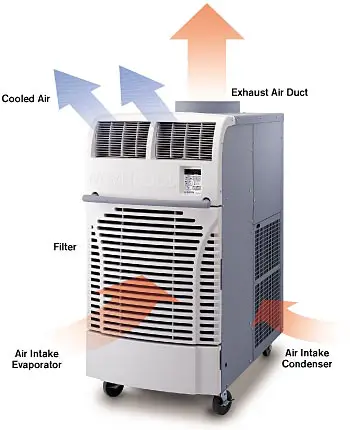
A self-evaporating portable air conditioner works in almost exactly the same way as a standard one.
It extracts warm air, cools it inside to remove the heat and moisture, and returns cold air into the room.
However, the condensed water doesn’t collect in a bucket or pass through a drainage hose. Instead, the air conditioner evaporates the liquid through a heating process that passes the warm air through a hose to the outside.
That’s why most self-evaporative portable air conditioners have window kits so that you can keep the openings closed and the heat outside while the device cools your home.
Why Do I Need a Self-Evaporating Portable Air Conditioner?
The number one reason to obtain a self-evaporating portable air conditioner is so you don’t need to spend your day worrying when you need to empty the bucket again. You can go about your life knowing that the device will deal with it for you.
Of course, the portability means you can move it around your house. With the installation kit, you can place it anywhere in your home where there’s a window.
Top Brands in the Self-Evaporating Portable Air Conditioner Space
You’ll notice that we selected specific brands for our best self-evaporating portable air conditioner reviews. While some have excellent products, others stand out more due to the name that signifies durability and performance.
Here are some of the top brands in the industry and why they stand out.
Honeywell
Honeywell has received an excellent reputation in the HVAC industry. It doesn’t merely supply dehumidifiers and purifiers but also self-evaporative portable air conditioners.
Established in 1885, Honeywell had come a long way from humble beginnings when it invented the first furnace regulator. Today, it sells several components for HVACs, and it’s a house-hold name known for reliability and durability.
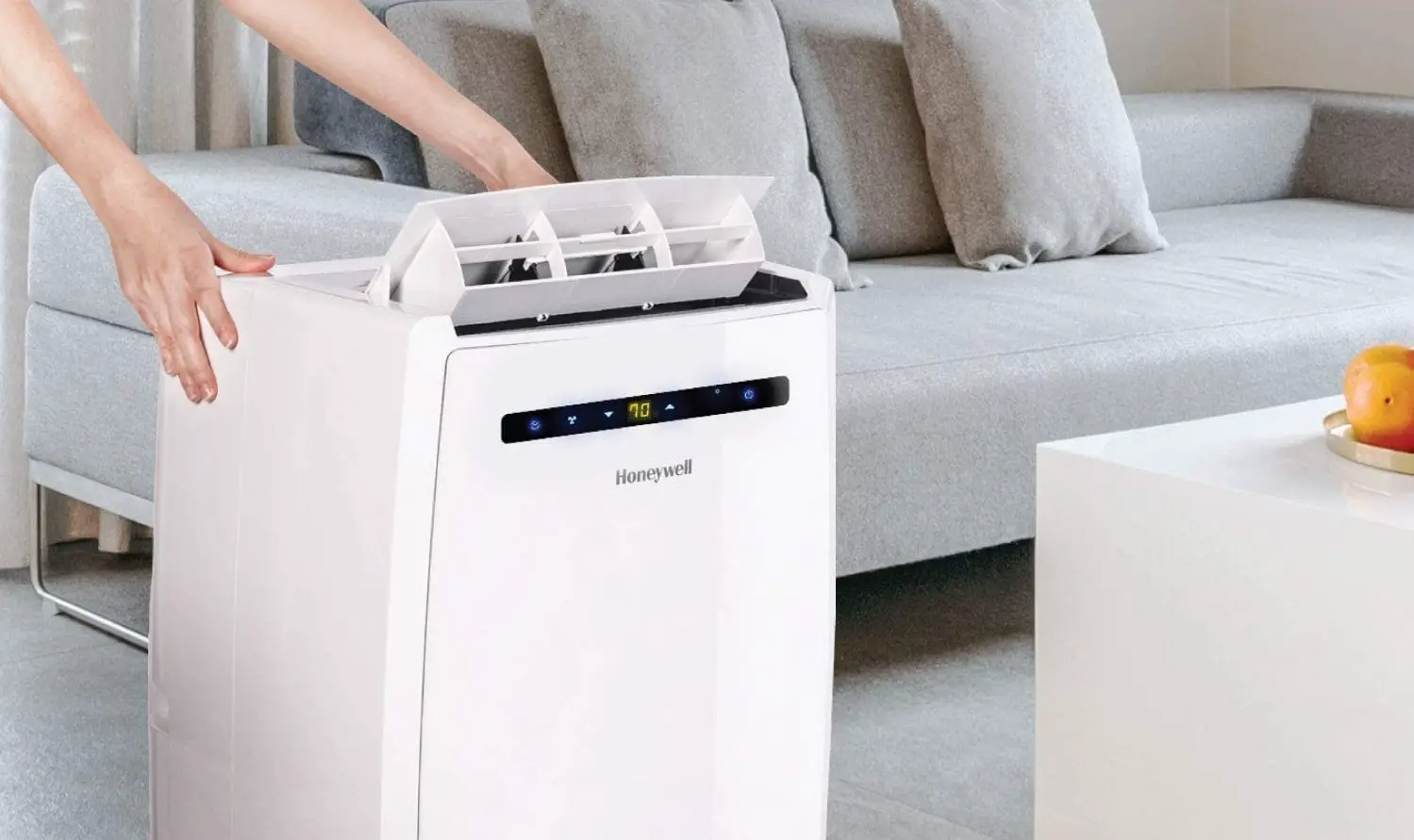
Black & Decker
Established in 1920 in Towson, Maryland, Black & Decker is a company that provides many household products. Some of the categories include power tools, lawn and garden, home cleaning, small appliance, batteries, and accessories.
Of course, it also has a hand in HVAC systems, delivering some of the most potent self-evaporating portable air conditioners on the market. It’s also gained a reputation for outstanding customer service and quality components.
LG
Formerly known as Goldstar, which started in 1958, LG Air Conditioning Technologies is a division of LG Electronics that has been an HVAC industry leader for several years. Its VRF Multi V product line has won several awards for ductless and ducted units.

LG has an extensive range of self-evaporative air conditioners for residential and commercial properties. Most customers turn to them for exceptional cooling and heating solutions for the most complex homes.
Pros of a Self-Evaporating Portable Air Conditioner
While we’ve discussed the pros and cons of each recommended self-evaporating portable air conditioner, you should also know the benefits as a whole.
We won’t be looking at general aspects, such as price and durability, but rather some of the more specific elements that make these devices stand out.
Low Maintenance
You won’t need to spend excess time and money cleaning and maintaining these devices. In most cases, they have filters that you can wash, and the components don’t suffer as much wear and tear as whole-house air conditioners.
No Need to Drain
Thanks to the technology that makes self-evaporating air conditioners unique, the condensed water is air-dried back out through the main exhaust pipe into the air outside. You won’t need to check every few hours to see if a bucket needs emptying.
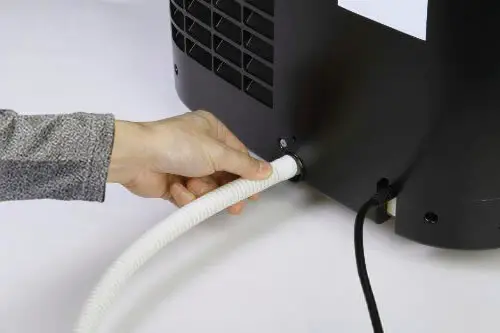
Easy Transport
Manufacturers design portable air conditioners for easy transport. You can uninstall the unit from the window bracket, move it to a new room via wheels, and reinstall it. You can also take it with you in your vehicle to a new home or on vacation.
Auto-Restart and Shut-off Functions
You may feel comfortable leaving your device on since you don’t need to drain it. However, the air conditioners have auto-restart and shut-off features to protect themselves from damage. Also, you can set these timers to save you electrical costs.
Excellent Cooling Capacity
You’d be surprised how well these self-evaporating portable air conditioners cool large homes. You can buy a 14,000 BTU for a 500 sq. ft. home, or you can buy a smaller unit for your apartment. The one common factor is that you’ll feel the cooling effect even on sweltering days.
Includes Dehumidification
Since the air conditioner removes moisture from the air and pumps it back outside, it includes a dehumidification function. Sure, it can’t compete with actual portable dehumidifiers with larger capacities in PPD, but you’ll still have lower humidity levels.
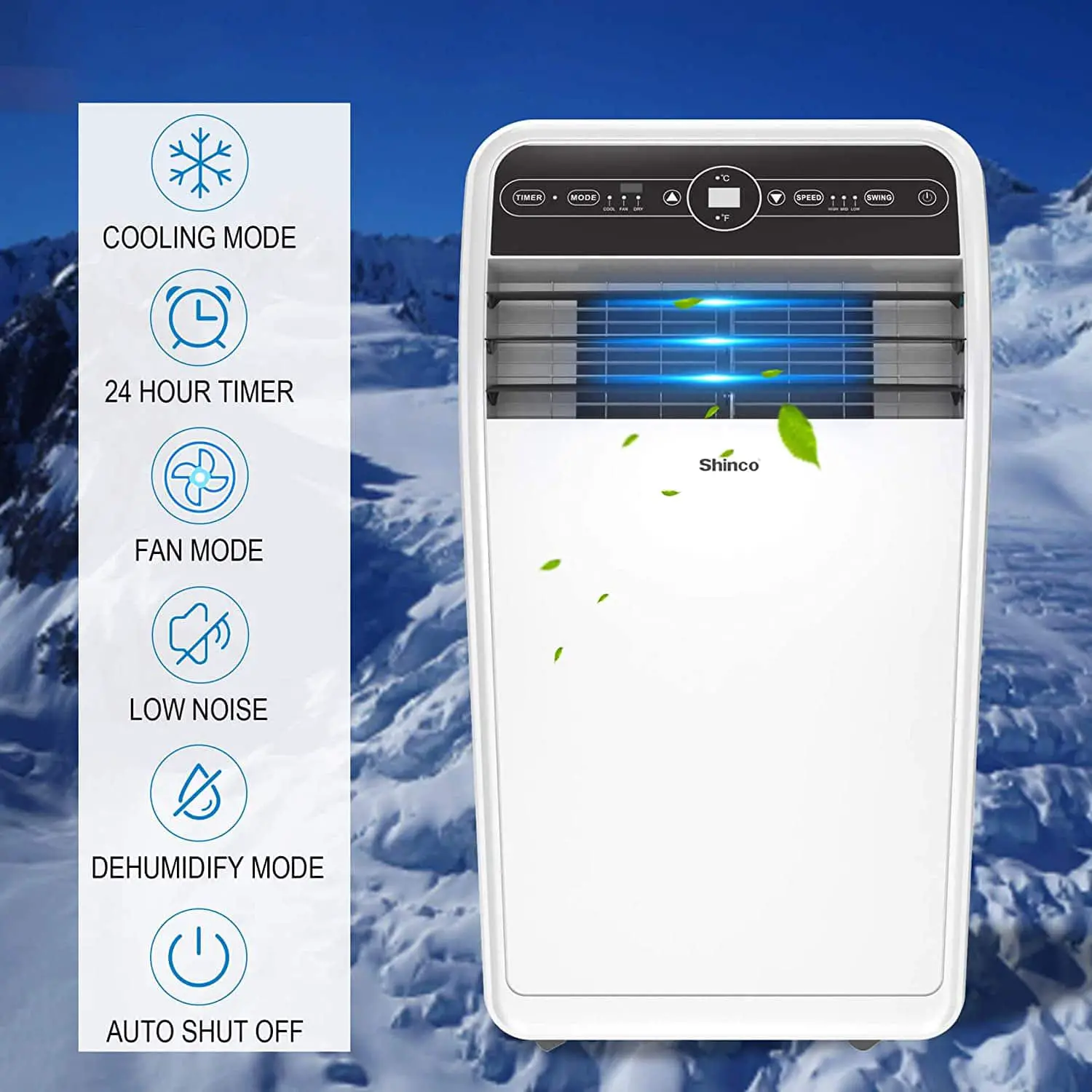
Cons of a Self-Evaporating Portable Air Conditioner
Of course, there are also some disadvantages you should consider before buying a self-evaporating air conditioner. Fortunately, the pros outweigh the cons.
Hoses Limit Portability
The downside to having hoses for evaporation is that they slightly limit transport. While it shouldn’t take you long to uninstall and reinstall, it’s still more effort than is needed with standard air conditioner units.
The other issue is if you take the air conditioner with you on vacation. You have no way of knowing whether the conditions at the destinations are suitable for the unit unless you’ve tested it beforehand.
Constant White Noise
The one liability of owning a powerful self-evaporative portable air conditioner is the constant hum at high settings. Unless the device has something to dampen the sound, that exhaust air will be pretty loud.
Of course, you might get used to it over time and find yourself sleeping through the night. The other option is having it at a low setting when you want to count sheep.
Larger Units Consume More Power
If you have a large space you need to cool, expect to pay more on your electrical bill. All that power requires energy, and some air conditioners are hungry and consume loads of electricity.
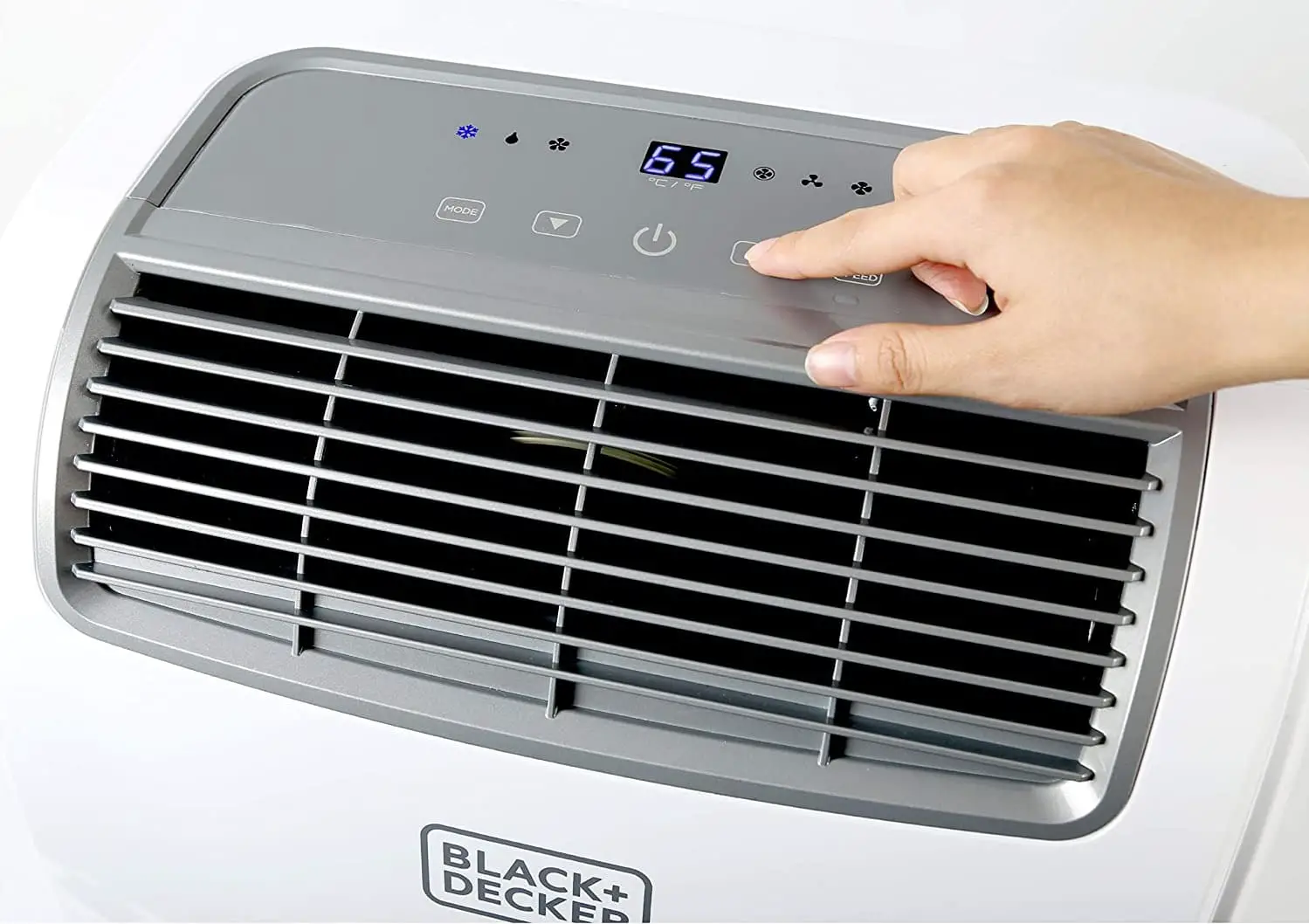
Price Points of Self-Evaporating Portable Air Conditioners
Of course, you’ll find different price ranges that speak to performance, durability, and quality. You can’t always judge an air conditioner by the price, but it’s a good measuring stick if you want to compare options.
Here’s a quick look at some price ranges and what you can expect.
$100 – $200
Self-evaporating portable air conditioners that fall in this bracket have the lowest BTU for cooling and limited features. You may find a remote and control panel, but there will be few modes and functions. You may even have to buy the installation kit and hose separately. Expect to use these in small spaces.
$200 – $500
These devices have higher BTUs, more durability, and better performance. You’ll find a few more functions included, and there will be installation kits for window frames. You might even see some of the top brands in this range, and they’re suitable for medium-sized rooms.
$500+
There’s no limit to how high this price can go. You’ll generally find air conditioners over 12,000 BTU that are made for larger spaces with improved reliability. The cream-of-the-crop accessories and functions will also be available, with several hose-size options.
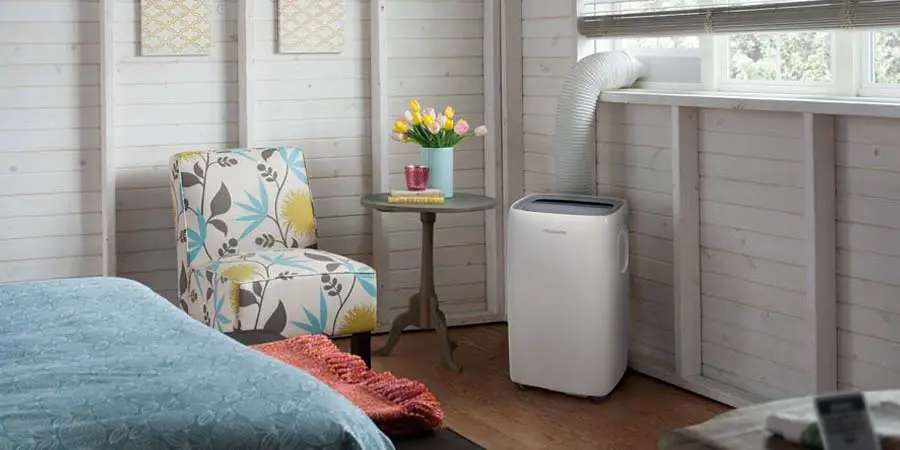
Who Should Not Buy a Self-Evaporating Portable Air Conditioner?
Now that we’ve looked at the practical application of self-evaporative portable air conditioners, it’s time to highlight in which situations you shouldn’t use these devices. It’s vital that you’re aware of these factors so that you don’t waste money.
When Cooling the Entire Home
It should be obvious that a portable air conditioner can’t be used to cool the entire house. When it comes to the self-evaporative variety, this fact is even more evident. It’s more cost-effective to purchase a whole-house air conditioner rather than putting a strain on your small device or budget.
In High Humidity Regions
Since the device is drawing in the warm air, cooling it down, and then evaporating vapor back into the air, the last thing you want to do is return moisture into your room if it suffers from high humidity. Sure, some of these air conditioners have a dehumidification function as well, but they don’t have the same performance as full dehumidifiers.
Homes With Incompatible Windows
While most self-evaporating air conditioners have installation kits, it doesn’t mean that they’re compatible with all windows. Some older houses have designs from a past era when there was no such thing as air conditioners.
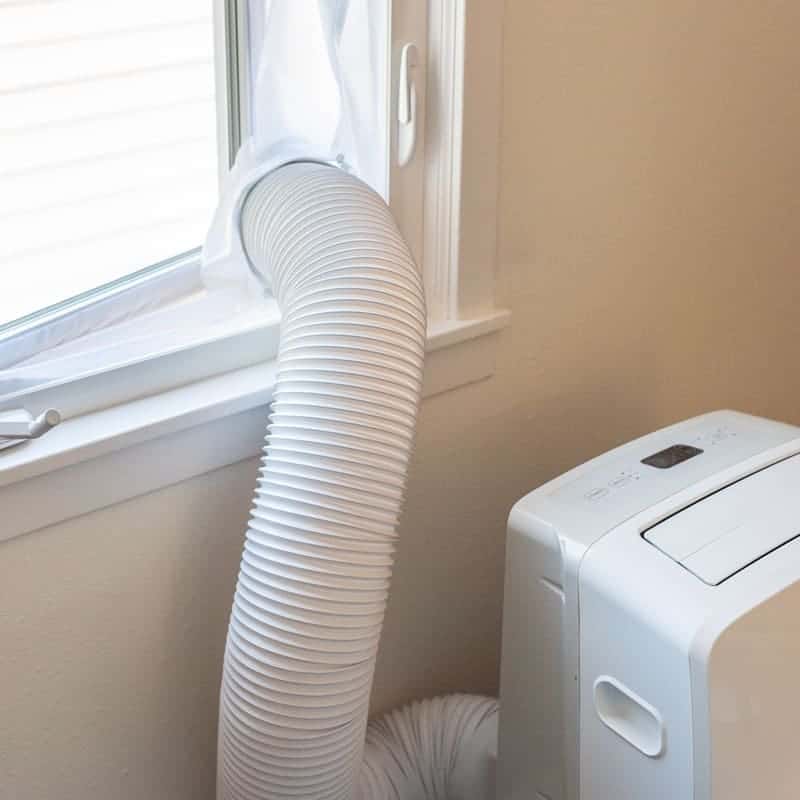
In these situations, you may want to look at standard portable air conditioners with the bucket collecting water at the bottom.
Restrictive Spaces
Yes, you can find small BTU units that will cool down your apartment or the room you rent in a communal home. However, your space may not be compatible, and you’ll struggle to move around the place if it gets in the way.
You also need to remember that there needs to be open space for effective air circulation. You won’t feel the effect of the cool air if there’s a blockage in the airflow.
For Mold and Water Damage
The idea that the air conditioner draws in air and partially acts as a dehumidifier may lead you to believe that it can reduce mold or water damage. Unfortunately, only full dehumidifiers were built for this purpose.
Conclusion
Self-evaporating portable air conditioners are ideal if you need cooling and ventilation, and you don’t want to continuously drain the tank. We’ve given you the list of the best options we recommend, and now you have a better idea of what to look for.
We hope you can now make the right decision and are more enlightened as to how these devices work. Remember to make 100% sure that this HVAC type is exactly what you need before you purchase it.
People Also Ask
You might have some questions that our article has left unanswered, or you’re not in the mood to read through it all. Here are some quick FAQs to help you out.
Due to the design of these units, you must place them in windows for the exhaust hose to pump out the warm evaporated air. Sure, you may find long hoses, but they’ll get in your way if placed inappropriately. You can also set it on a table to help promote air circulation.
The best way to tell if the air conditioner is self-evaporating is to feel if there’s warm air leaving the exhaust hose. Head outside the window where the hose is installed and place your hand nearby. You should feel the vapor escaping.
No, as the whole point of the device is to take this act out of the equation. It evaporates the water that it collects through the house, leaving no water remaining inside.
